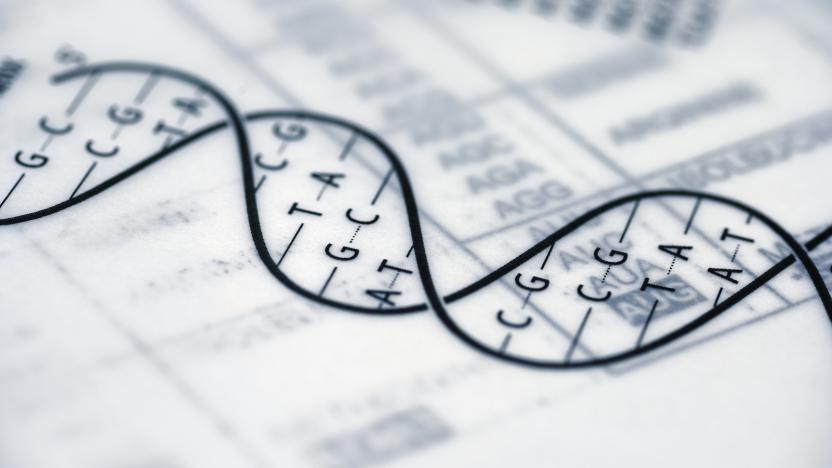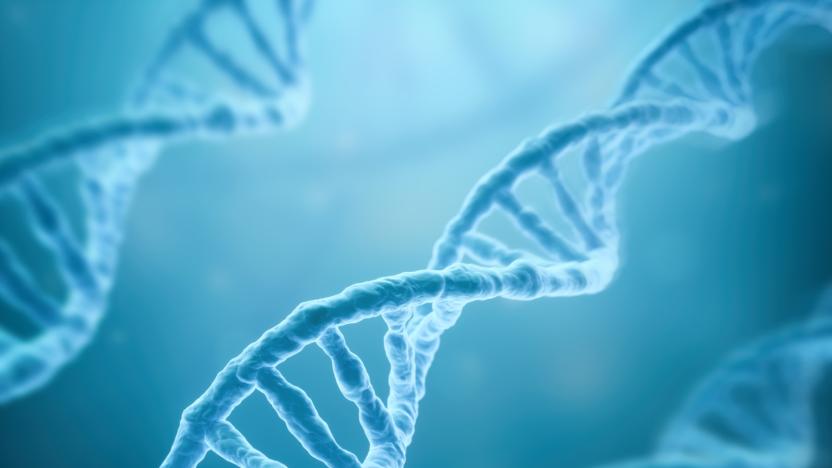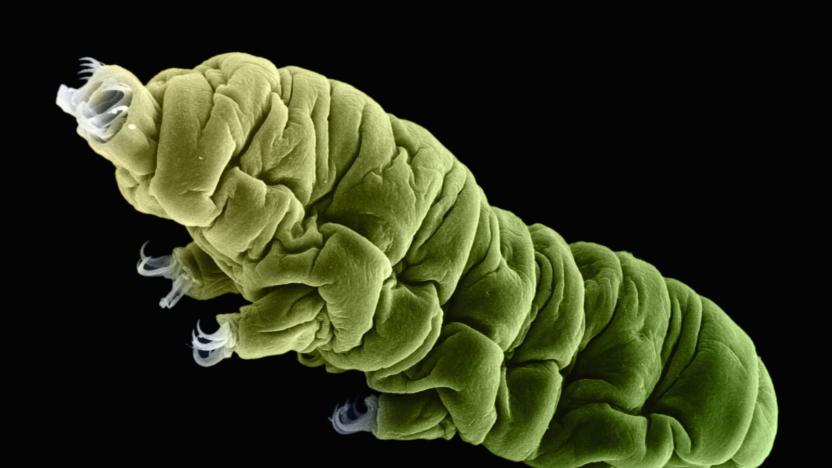genome
Latest

Scientists sequence 64 human genomes to better reflect genetic diversity
Scientists have sequenced 64 full human genomes to better understand genetic diversity in the species.

Science takes a step toward coding virus-resistant human cells
In 2016, scientists unveiled one of the most ambitious genetic engineering efforts yet: Genome Project-write wanted to do nothing less than create (not just edit) human cells immune to all known viruses. There was a rough start that included dramatic funding shortfalls, but it now looks like the initiative is getting underway in earnest. Harvard's Wyss Institute and French immunotherapy company Cellectis have formed a partnership that will see Cellectis supply genome engineering tools to a Wyss team led by George Church. They'll use custom enzymes to remove redundant codons (nucleotide "triplets" that produce amino acids for specific proteins) and prevent viruses with those codons from hijacking cells to produce copies of themselves.

Yeast could hold the key to custom-built DNA
Scientists have been playing with DNA for a long time, but now researchers are taking things a step further by building DNA from scratch in a bid to conquer life's blueprint. An international team of 11 labs from four continents are working together to "rewrite" the yeast genome, a project which could reveal the hidden rules that govern the structure of all living things. The controversial work, headed up by New York University, aims to enable scientists to create custom-made DNA codes. These could then be placed into living cells, changing how they function and giving valuable insight into disease. Much further down the line, scientists may even be able to create entirely new organisms. The right adjustments could also make yeast create new, efficient biofuels.

Helix wants to build a marketplace for your DNA
There are secrets buried deep within our genetic code, and more than a few companies that want to help you learn them. Helix believes that the gaggle of startups vying for your DNA have a problem: they all need an individual sample to use. That's why the company is positioning itself as a marketplace where you take a single DNA swab, and then it shares the information with whoever you choose.

Scientists find a low-cost way to build genomes from scratch
To put it mildly, sequencing and building a genome from scratch isn't cheap. It's sometimes affordable for human genomes, but it's often prohibitively expensive (hundreds of thousands of dollars) whenever you're charting new territory -- say, a specific person or an unfamiliar species. A chromosome can have hundreds of millions of genetic base pairs, after all. Scientists may have a way to make it affordable across the board, however. They've developed a new method, 3D genome assembly, that can sequence and build genomes from the ground up for less than $10,000.

'Water Bear' protein could shield human DNA from radiation
Tardigrades, aka 'water bears,' are microscopic organisms that survive in harsh environments from the antarctic to oxygenless space. They are so robust that Japanese scientists froze a group of them for 30 years and successfully revived two specimens. But to understand what makes these tiny creatures so impervious, another group of researchers took a closer look at their genes. By mapping the entire genome of a particularly stress-tolerant tardigrade species, Ramazzottius varieornatus, they found a protein that protects DNA from being irradiated — which could be used to shield humans.

Scientists held a secret meeting to debate creating synthetic human genes
On Tuesday, about 150 scientists, lawyers and entrepreneurs gathered at Harvard Medical School to discuss a future project to improve techniques to synthesize human DNA from chemicals. But they held the meeting behind closed doors, with explicit instructions not to contact the media, getting the scientific community in a tizzy. At the top of their worry pile is that the project will end up innovating new ways to make synthetic human genes, which could lead to them being used to artificially create humans.

Human-made bacteria has the tiniest genome ever
Believe it or not, creating artificial life (albeit based on existing species) isn't new. However, scientists have managed a particularly unusual feat: they've built synthetic bacteria that has the smallest known genome of any lifeform... ever. Their modification of Mycoplasma mycoides has just 473 genes, or so few that it likely couldn't survive and reproduce if you shrank the genome further. The trick was to do a better job of determining which genes were essential. Many of those that weren't deemed necessary in the past turned out to be half of a vital pair, giving researchers a good sense of what they could afford to cut.

Scientists decode the bedbug's genes to help kill it
Just the very thought of bedbugs probably makes your skin crawl, and that's made all the worse by their ability to adapt to new threats. Like it or not, that pesticide you used years ago probably doesn't work any more. What to do? Genetics might just come to the rescue. Scientists have created the first full genome sequence for the bedbug in hopes of defeating its resistance to sprays and other attempts at extermination. You'd think this would have been easy (humans can sequence woolly mammoths, for goodness' sake), but it wasn't -- the team had to compare bedbug genes from 1973 with present-day samples, and even the differences before and after the bugs had their blood meals.

Scientists turn to crowdfunding to safeguard black rhino DNA
Crowdfunding isn't just useful for getting clever inventions off the ground... it could also save an endangered species from fading into oblivion. Scientists have successfully funded a project that will sequence the genome of the black rhino, only 5,055 of which live in the wild. The public-backed effort will improve our understanding of how these iconic animals work, and should lead to synthetic horns that discourage poachers. It could even lead to resurrecting black rhino subspecies that are already extinct. It'll be a while before you see the results, but they'll be available to the public -- that small amount of backer money could do a world of good. [Image credit: AP Photo/Sayyid Azim]

DNA sequencing shows how woolly mammoths got that way
In what is being called the "most comprehensive" study of its kind, a team from the University of Chicago claims that it has revealed the massive amount of genetic change needed for woolly mammoths to adapt to their arctic environment. The study, which was published on July 2 in Cell Reports, shows that genes controlling everything from skin and hair development to fat metabolism, insulin signaling -- even skull shape -- differed from their contemporary elephant kin.

Human gene sequencing gets an official yardstick
Gene sequencing, once a rare feat, is pretty common these days... but how do you know that your DNA data is up to snuff? As of now, there's an easy way to find out. The National Institute of Standards and Technology (NIST) has released reference genetic material that serves as a "measuring stick" for human gene sequencing. Researchers have tested this sample genome so thoroughly that it'll tell labs whether or not they're making typical mistakes, and ensure that their results are trustworthy. The hope is that you'll see bulletproof sequencing devices that take the anxiety out of pinpointing genetic conditions or understanding your ancestry. [Image credit: Gerald Barber, Virginia Tech University (with permission of the National Science Foundation)]

Epic Games challenges VR devs to make sense of big data
We've seen a handful of neat ways to visualize big data and make it useful, and the folks behind Unreal Engine, Epic Games, think virtual reality is the next step for that. Currently a half-dozen international teams are taking part in the Big Data VR Challenge, and hope their expertise with games and VR will help 'em "find new ways to manipulate and interrogate" the massive amounts of info generated by science studies. As of now, projects include putting together a digital edition of one of medical history's largest collections of patient consultations (some 80,000 participants) from the 16th and 17th century and a cohort study of kids born between 1991 and 1992.

NIH bans funding for genetic engineering of human embryos
Researchers from Sun Yat-sen University in Guangzhou, China made headlines late last month upon announcing that they had successfully edited the genes of a human embryo. This revelation set off a firestorm of controversy as the scientific community took sides in the ethical debate of genetic manipulation. Now, the National Institute of Health has weighed in on the issue and is denying funding to research that involves meddling with the human germline.

The UK will decode the genes of 100,000 people to help fight cancer
The UK is about to launch one of the more ambitious attempts at using genetic research to fight cancer and other nasty diseases. The National Health Service's England branch plans to collect and sequence the genomes of 100,000 people in hopes of understanding both how DNA affects these sicknesses (such as gene-specific causes or symptoms) and what doctors can do to test and treat patients. The strategy will see the NHS run 11 specialized Genomic Medicine Centres across England, with more due in the future. So long as everything goes smoothly, the first recruits will sign up in February.

Google's putting autism genome research in the cloud
Remember when Google said it'd store your entire genome on its servers? Well, the outfit is putting that to good use and is teaming with advocacy group Autism Speaks to sequence the genomes of some 10,000 autism patients (and their family members). In case you're wondering why, it's so we can hopefully discover the disorder's genetic origins. As Wired notes, this would allow researchers to sort through the roughly 100GB -- per person -- of genetic data in a way that's similar to how we search for things online. Except, of course, the scientists would be looking for genetic commonalities in those with Autism rather than, say, leaked images of a new iPhone.

Genome testing is now easy, fast and pretty
Genome testing gear doesn't get a lot of love. Like a lot of lab equipment, it tends to be ugly and unwieldy -- it's not designed with the same elegance as the smartphone in your pocket. Mercifully, the crew at Fluidigm appears to have solved those problems in one shot with its Juno genotyping machine. The Yves Behar-designed device is (dare we say it) pretty, and wouldn't look out of place sitting on a desk. It's also more intuitive, relying on a large, simple touchscreen interface instead of keyboards and tiny displays.

Google Genomics can store your entire genome online for a mere $25 a year
Google's been working on its latest project for about a year and a half ago: it's service that will store entire copies of genome. This isn't something Google Drive can cope with - decoding DNA involves a lot of data. According to Technology Review, in raw data, one person's genome weighs in at around 100 gigabytes. The plan is house all that DNA data online, in big 'ole clouds where scientists will be able to run virtual experiments and collaborate with each other on bigger (hopefully disease-curing) projects. Google is battling against the likes of Amazon and Microsoft to store expansive medical data like this: the Mountain View company charges scientists and researchers $25 a year for storing a single human genome -- although you'll have to pay a little more to fiddle around with data.

One Codex wants to make searching DNA as easy as using Google
Once upon a time, sequencing your genome was a prohibitively expensive proposition -- mapping out your genetic code cost hundreds of thousands of dollars and the practical applications of the data were few and far between. These day the process is so affordable that health care professionals are sitting on petabytes of genome data. Making use of that data, however, is another problem. The current genome searching algorithm, called BLAST, isn't particularly fast. A new firm hopes to change that, and is introducing One Codex: a genetic search platform that can index DNA base pairs 1,500 faster than contemporary databases.

Researchers fully 'delete' HIV from human cells for the first time
So far, HIV has eluded a cure because it installs its genome into human DNA so insidiously that it's impossible for our immune system to clear it out. While current treatments are effective, a lifetime of toxic drugs is required to prevent its recurrence. But researchers from Temple University may have figured out a way to permanently excise it using a highly-engineered HIV "editor." Here's how it works: the team analyzed a part of our immune system that fights infection and built a "guide RNA" strand consisting of 20 nucleotides (RNA building blocks). Those strands were then injected into cells typically infected with HIV, like T-cells. There, they targeted the end parts of the virus's gene and snipped out all 9,709 nucleotides that made up its genome. Since the guide RNA strand contained no human DNA sequences, it left the host cell intact -- but free from HIV.








